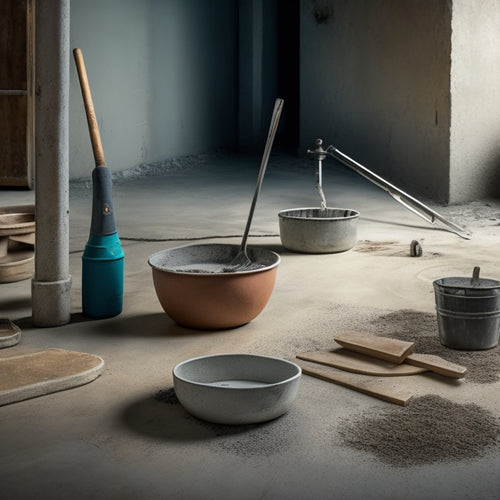
What Are the Best Concrete Adhesion Tools
Share
You'll need a range of specialized tools to guarantee a strong, lasting bond between concrete surfaces and adhesives. Identify the concrete type to determine specific bonding requirements, and assess curing techniques affecting surface porosity. Utilize surface profilers for ideal surface roughness and remove contaminants using degreasers and wire brushes. Select adhesive applicators that provide consistent bondline thickness and minimal mess, and apply bonding agents to guarantee strong hold. Don't forget to test and measure surface energy, roughness, and adhesion strength with specialized tools. By choosing the right tools, you'll be well on your way to achieving excellent concrete adhesion - and there's more to explore to secure project success.
Key Takeaways
• Identify concrete type to determine specific bonding requirements for optimal adhesion.
• Utilize surface profilers to achieve ideal surface roughness for strong bonding.
• Select adhesive applicators that ensure consistent bondline thickness and minimal mess.
• Apply high-quality bonding agents, such as epoxy or polyurethane-based primers, for enhanced adhesion.
• Employ testing and measuring tools, like surface energy testers and adhesion testers, to verify bonding suitability.
Essential Tools for Concrete Bonding
When preparing a concrete surface for bonding, you'll need to equip yourself with the right tools to confirm a strong, long-lasting adhesion. The type of concrete you're working with will greatly impact the bonding process, so it's crucial to identify the concrete type and its specific requirements. For instance, high-strength concrete may require specialized equipment to guarantee proper surface preparation.
Next, you'll need to assess the curing techniques used on the concrete. Different curing methods can affect the surface's porosity, which in turn affects adhesion. Understanding the curing process will help you choose the right tools to achieve the best bonding. A surface profiler, for example, can help you achieve the ideal surface roughness for bonding.
Additionally, you'll need to remove any contaminants, such as dirt, oil, or old adhesives, to guarantee a clean bonding surface. A degreaser and a wire brush can be effective tools for this step.
Adhesive Applicators for Smooth Finish
You'll achieve a smooth, even finish by selecting the right adhesive applicators, which guarantee consistent bondline thickness and minimal mess. These applicators are designed to optimize adhesive techniques, guaranteeing a uniform distribution of the bonding agent.
When it comes to application methods, you'll need to choose between manual or automated systems. Manual applicators, such as notched trowels or rollers, offer precise control and flexibility, making them ideal for intricate or small-scale projects. Automated applicators, like extrusion machines or robotic systems, provide high-speed application and are better suited for large-scale projects or high-volume production.
Regardless of the application method, it's crucial to select an adhesive applicator that's compatible with your chosen adhesive. Some applicators are designed for specific adhesive types, such as epoxy or polyurethane, so be sure to check the manufacturer's recommendations.
Surface Preparation Made Easy
To guarantee a strong bond between the concrete and adhesive, prepare the surface by removing dirt, oils, and other contaminants that can compromise adhesion.
You'll need to perform thorough surface cleaning to verify a clean slate for bonding. Use a degreaser or a solvent-based cleaner to remove grease, oil, and wax. For heavy dirt buildup, consider using a pressure washer to blast away debris.
Next, focus on texture enhancement. A rougher surface provides more surface area for the adhesive to bond to, resulting in a stronger hold. You can use a wire brush or a concrete scraper to roughen the surface. Be cautious not to over-roughen, as this can create micro-cracks that can compromise adhesion.
After surface cleaning and texture enhancement, inspect the surface for any remaining contaminants or defects. Make any necessary repairs before applying the adhesive.
Bonding Agents for Strong Hold
As you move forward with your concrete adhesion project, it's vital to take into account the role of bonding agents in achieving a strong hold. Frequently, a bonding agent is applied to the prepared surface to guarantee a strong hold between the concrete and adhesive.
You're likely to achieve the best results with a high-quality epoxy- or polyurethane-based primer. These primers enhance the adhesion properties of the concrete, allowing for a more secure bond between the substrate and the adhesive.
When selecting a bonding agent, it's important to choose a product that complements your specific bonding techniques. Epoxy-based primers are ideal for high-strength applications, while polyurethane-based primers offer excellent flexibility and resistance to moisture.
Regardless of the type, a high-quality bonding agent will greatly improve the adhesion properties of the concrete, ensuring a durable and long-lasting bond.
Testing and Measuring Tools
Testing and Measuring Tools
Before applying adhesives, measuring the surface energy of your concrete substrate is essential to guarantee ideal bonding. This is where testing and measuring tools come into play. You need to verify that the surface is clean, dry, and free of contaminants that can compromise adhesion strength.
Testing and measuring tools help you assess the surface roughness, which directly affects the bonding process.
| Testing Tool | Function |
|---|---|
| Surface Energy Tester | Measures surface energy to determine ideal bonding conditions |
| Adhesion Tester | Evaluates adhesion strength between the concrete substrate and adhesive |
| Roughness Tester | Assesses surface roughness to optimize bonding conditions |
| Moisture Meter | Detects moisture levels to prevent bonding failures |
| pH Meter | Measures the pH level of the concrete substrate to verify compatibility with adhesives |
Frequently Asked Questions
Can I Use Concrete Adhesion Tools on Freshly Poured Concrete?
When working with fresh concrete, you'll need to exercise caution when applying adhesion tools. Fresh concrete is more porous, making it challenging for adhesives to form a strong bond.
To guarantee effective fresh concrete bonding, you'll want to employ specialized adhesive application techniques. This may involve using primer coats, controlling surface moisture, or utilizing advanced bonding agents.
Are Concrete Adhesion Tools Suitable for All Types of Concrete?
When working on a project like the iconic Sydney Opera House's concrete restoration, you'll encounter varying concrete types.
Are concrete adhesion tools suitable for all of them? Not necessarily. You'll need to assess the concrete surface preparation requirements for each type, guaranteeing the adhesive product compatibility.
For instance, epoxy-based adhesives work well with high-strength concrete, but may not be ideal for low-strength or porous concrete.
You must carefully select the right tool and adhesive for your specific concrete type to guarantee a strong bond.
How Do I Store Concrete Adhesion Tools When Not in Use?
When you're not using your concrete adhesion tools, proper storage is essential to maintain their effectiveness.
You'll want to organize them in a dry, clean area, away from direct sunlight and moisture.
Use a designated toolbox or storage bin with dividers to keep each tool separate and easily accessible.
This will prevent damage, rust, and corrosion, ensuring your tools remain in top condition for the next project.
Can I Rent Concrete Adhesion Tools Instead of Buying?
You may think renting concrete adhesion tools is a hassle, but it's actually a viable option.
If you only need them for a one-time project, rental options might be the way to go.
Compare the cost of buying versus renting, and you'll likely find that renting saves you money in the long run. Plus, you won't have to worry about storing them when not in use.
Research local equipment rental companies to find the best rates and tools for your specific needs.
Do Concrete Adhesion Tools Require Regular Maintenance?
You'll want to factor in maintenance frequency when investing in concrete adhesion tools.
Regular upkeep is essential to extend tool longevity and guarantee peak performance.
You should clean and inspect your tools after each use, and perform more thorough maintenance tasks, like replacing worn parts, every 3-6 months.
Conclusion
As you prepare to tackle your concrete bonding project, remember that the right tools can make all the difference.
Having a thorough toolkit guarantees a strong, long-lasting bond between old and new concrete.
You may think, 'But I've gotten by without these tools before.' However, without them, you risk compromising the integrity of your project.
Invest in the best concrete adhesion tools to assure a professional finish and avoid costly rework.
Related Posts
-

3 Best Hand Tools for DIY Concrete Construction
When tackling a DIY concrete construction project, you'll need three essential hand tools to achieve a professional-l...
-

Essential Power Tools for DIY Concrete Sculpting
As you begin DIY concrete sculpting, you'll need a strategic selection of power tools to achieve professional-grade r...
-

Why You Need These Concrete Overlay Tools
When tackling a concrete overlay project, you need the right tools to achieve a flawless finish and avoid costly mist...


